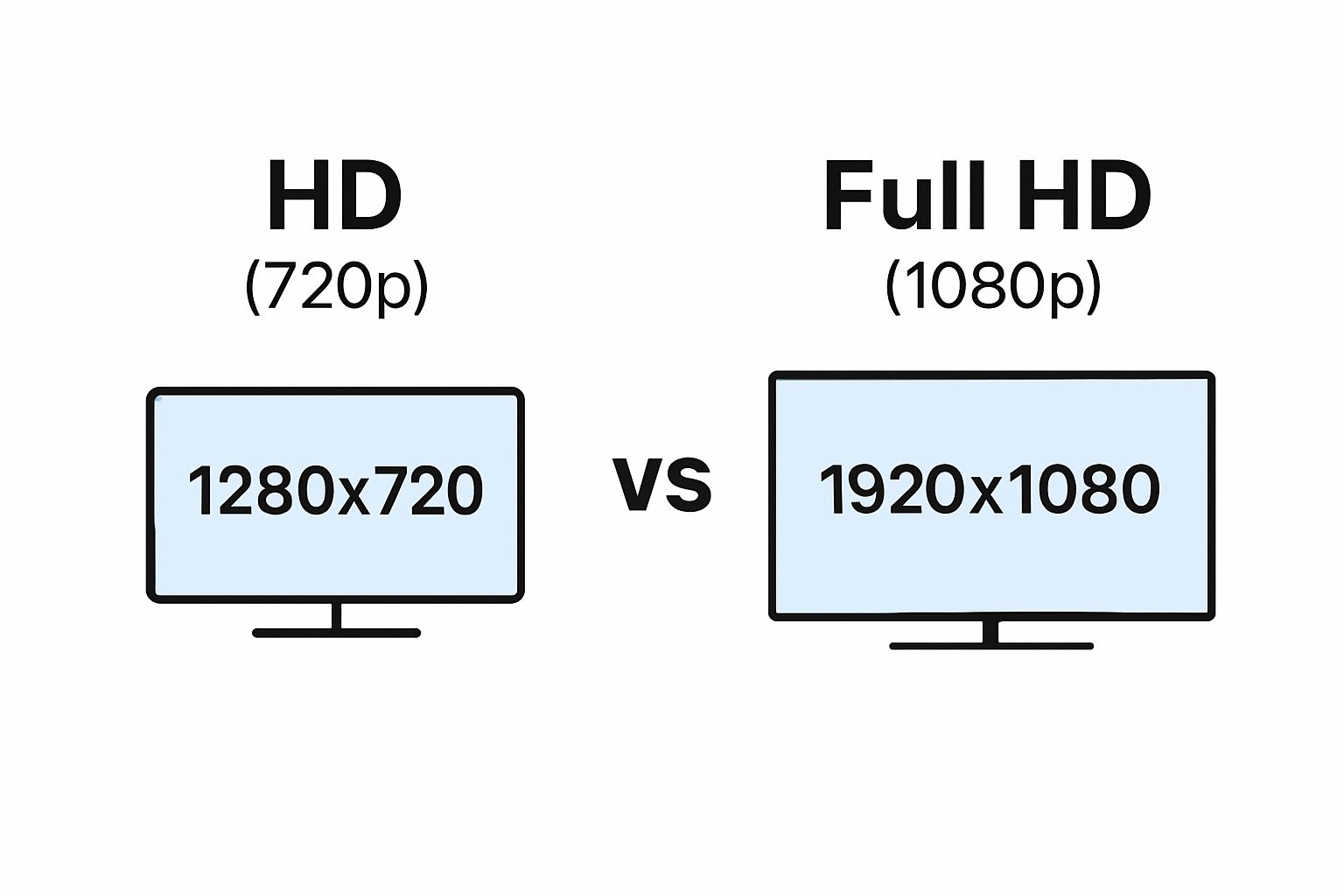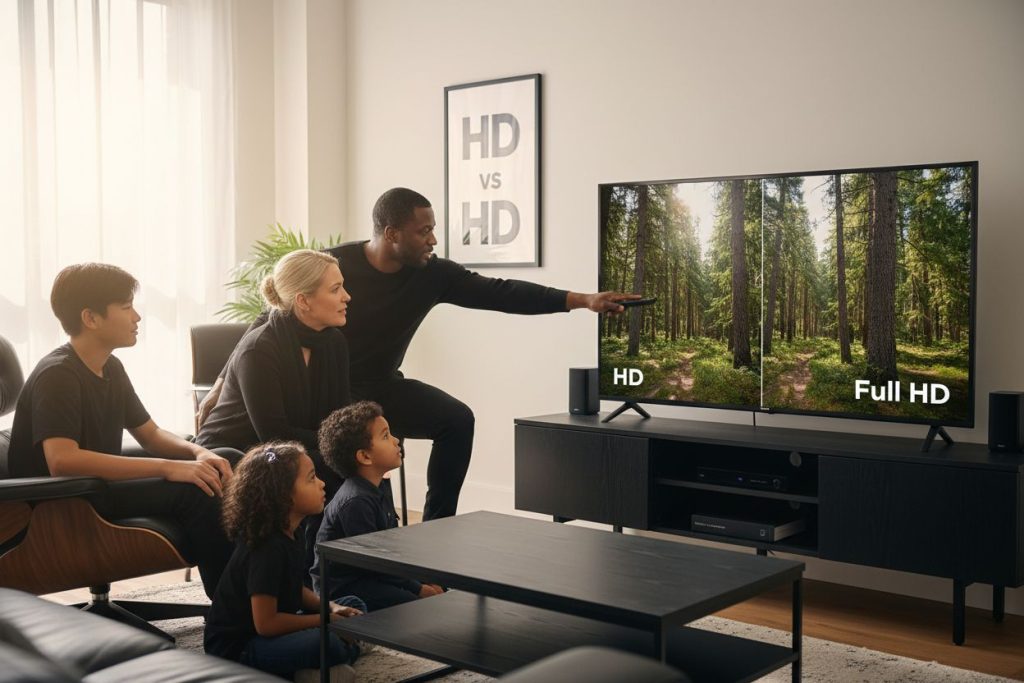Everyone wants sharper, more vibrant screens on their TVs, laptops, and phones. Full HD packs in over 2 million pixels, more than double the count in regular HD screens. Most people think that means every modern display looks equally stunning. Not quite. The real story is in how each pixel works together and why, for many situations, HD and Full HD make a bigger difference than you might expect.
Table of Contents
- What Is Hd And Full Hd? Understanding The Basics
- Why The Difference Between Hd And Full Hd Matters
- How Hd And Full Hd Work: The Technology Behind Them
- Key Concepts Of Resolution: Pixels And Clarity
- Real-World Applications: Choosing Between Hd And Full Hd
Quick Summary
| Takeaway | Explanation |
|---|---|
| Understand resolution basics: HD vs. Full HD | HD is 720p (1280×720), while Full HD is 1080p (1920×1080). Knowing these differences is crucial for making informed technology choices. |
| Full HD delivers superior visual quality | Full HD's higher pixel count (over 2 million vs. 921,600 in HD) translates to sharper images and better color accuracy, enhancing the viewing experience. |
| Choose resolution based on context | Evaluate your needs: Full HD is ideal for larger screens and detailed visuals; HD may suffice for smaller displays and less demanding applications. |
| Resolution affects professional applications | Graphic designers and video producers benefit from higher resolutions like Full HD for detailed work and accurate visual representation. |
| Consider budget and technology constraints | While Full HD offers better quality, it usually costs more. Weigh your budget against necessary quality to find the right balance. |
What is HD and Full HD? Understanding the Basics
When exploring display technologies, understanding resolution becomes crucial. HD (High Definition) and Full HD represent two fundamental video and display resolution standards that significantly impact visual quality across devices like televisions, projectors, computer monitors, and smartphones.
Resolution Fundamentals
Resolution describes the number of pixels that compose an image horizontally and vertically. Think of pixels as tiny digital building blocks that create visual clarity and detail. In HD and Full HD contexts, this translates directly into picture sharpness and information density.

- HD (720p): Consists of 1280 horizontal pixels and 720 vertical pixels
- Full HD (1080p): Offers 1920 horizontal pixels and 1080 vertical pixels
Technical Differences
The primary distinction between HD and Full HD lies in pixel count. Full HD resolution provides considerably more visual detail compared to standard HD. With approximately 921,600 pixels in HD versus 2,073,600 pixels in Full HD, the difference becomes immediately noticeable in image clarity and refinement.
For visual professionals, content creators, and tech enthusiasts, understanding these resolution standards helps make informed decisions about display technologies. While HD remains acceptable for smaller screens, Full HD delivers superior image quality, especially on larger displays where pixel density becomes more apparent.
To help clarify the technical distinctions between HD and Full HD, the following table compares their core specifications, visual impact, and typical use cases.
| Feature | HD (720p) | Full HD (1080p) |
|---|---|---|
| Resolution (WxH) | 1280 x 720 | 1920 x 1080 |
| Total Pixels | 921,600 | 2,073,600 |
| Image Clarity | Moderate | High |
| Best For | Smaller screens, casual TV | Large screens, detailed work |
| Color Reproduction | Good | Excellent |
| Typical Uses | Basic TV, entry laptops | Movies, gaming, design |
| Standard Status | Older standard | Modern default standard |
Practical Implications
When selecting projectors, monitors, or televisions, resolution plays a critical role. Full HD has become the standard for most modern devices, offering:
- Enhanced image sharpness
- Better color reproduction
- Improved viewing experience for multimedia content
- Compatibility with contemporary digital content
Whether you are watching movies, playing video games, or creating professional presentations, understanding HD versus Full HD helps you make more strategic technology choices that align with your visual quality expectations.
Why the Difference Between HD and Full HD Matters
The distinction between HD and Full HD extends far beyond mere technical specifications. This resolution variance profoundly impacts visual experiences across multiple domains, from entertainment to professional applications.
Visual Experience and Perception
Resolution directly influences how we perceive and interact with digital content. Advanced projection technologies in Malaysia highlight the critical importance of pixel density. Full HD provides significantly more detailed imagery compared to standard HD, which becomes increasingly apparent in scenarios requiring high visual precision.
Key perceptual differences include:
- Enhanced clarity of fine details
- More accurate color representation
- Reduced visual artifacts
- Improved depth and texture perception
Professional and Creative Applications
For professionals in graphic design, video production, architectural visualization, and medical imaging, resolution is not just a technical specification but a fundamental tool. Full HD resolution delivers substantially more information, enabling more accurate visual analysis and representation.
Creative professionals rely on higher resolutions to:
- Capture intricate design elements
- Maintain image quality during post-processing
- Present precise visual representations
- Ensure compatibility with modern display standards
Entertainment and Multimedia Impact
In entertainment contexts, the resolution difference becomes dramatically noticeable. Movies, video games, and streaming content leverage Full HD to provide immersive, lifelike experiences. The additional pixels translate into sharper images, more vibrant colors, and a sense of depth that standard HD cannot replicate.
While HD remains functional, Full HD has become the minimum standard for discerning viewers who demand superior visual quality. As display technologies continue evolving, understanding these nuanced differences helps consumers make informed decisions about their visual technology investments.
How HD and Full HD Work: The Technology Behind Them
Understanding the technological mechanisms behind HD and Full HD resolution requires exploring the intricate world of digital display engineering. These standards represent sophisticated systems that transform digital information into visual experiences.
Pixel Architecture and Display Mechanics
Pixels act as the fundamental building blocks of digital imagery. In HD and Full HD technologies, these microscopic elements work together to recreate visual information with remarkable precision. Projection technology in Malaysia exemplifies how these pixel configurations translate into stunning visual outputs.
Each pixel comprises three sub-pixels in primary colors:
- Red
- Green
- Blue
By varying the intensity of these sub-pixels, displays can generate millions of color combinations, creating rich and nuanced visual representations.
Signal Processing and Rendering
Digital signals undergo complex processing before becoming visible images. Display devices interpret incoming video signals, mapping pixel information across the screen. Full HD systems process substantially more data compared to standard HD, enabling more sophisticated image rendering.
The rendering process involves:
- Decoding digital video signals
- Mapping pixel coordinates
- Adjusting color and brightness levels
- Synchronizing frame rates
Technological Evolution and Performance
Resolution standards represent ongoing technological progression. While HD provided significant improvements over previous analog systems, Full HD represents a more advanced approach to visual information representation. Modern displays use increasingly sophisticated techniques like interpolation and upscaling to enhance image quality.
The transition from HD to Full HD reflects continuous innovation in digital display technologies, delivering increasingly immersive and accurate visual experiences across various devices and applications.
Key Concepts of Resolution: Pixels and Clarity
Resolution represents the intricate language of visual digital technology, where pixels serve as the fundamental vocabulary for creating detailed and compelling imagery. Understanding this language allows us to appreciate how digital displays transform raw data into meaningful visual experiences.
Pixel Fundamentals
Pixels are the smallest discrete units of digital visual information. Understanding resolution in projectors reveals how these tiny elements combine to create comprehensive images. Each pixel functions like a microscopic color-changing tile, capable of producing millions of distinct color combinations through precise intensity adjustments.
Pixel characteristics include:
- Microscopic size (typically measured in micrometers)
- Ability to change color instantaneously
- Arranged in precise horizontal and vertical grids
- Varying levels of color intensity
Resolution and Visual Perception
Resolution directly impacts how humans perceive visual information. Higher pixel densities create smoother, more nuanced images that closely mimic real-world visual experiences. The human eye can distinguish increasingly fine details as pixel count increases, making resolution a critical factor in display quality.

Key perceptual elements include:
- Sharpness of image edges
- Color gradient smoothness
- Detail visibility at different viewing distances
- Perceived depth and texture
Technological Implications
Digital resolution transcends simple pixel counting. Modern display technologies leverage sophisticated algorithms to interpolate and enhance visual information, creating increasingly realistic representations. From medical imaging to cinematic experiences, resolution continues to push the boundaries of visual communication.
The ongoing evolution of pixel technology demonstrates how seemingly abstract mathematical configurations translate into profound visual experiences that shape our digital interactions.
Real-World Applications: Choosing Between HD and Full HD
Selecting the appropriate resolution involves understanding specific use cases and performance requirements across various domains. Resolution is not a one-size-fits-all solution but a nuanced choice depending on individual needs and technological contexts.
Professional and Creative Environments
In professional settings, visual precision becomes paramount. Comparing 4K and Full HD projectors highlights the critical role of resolution in different professional scenarios. Graphic designers, video editors, and architectural professionals typically require Full HD or higher to ensure accurate visual representation.
Key professional considerations include:
- Detailed image analysis
- Color accuracy requirements
- Complex visual rendering needs
- Precision in visual communication
Entertainment and Multimedia Applications
Entertainment contexts demand different resolution strategies. While gaming, streaming, and home theater experiences benefit significantly from Full HD, some scenarios might find standard HD perfectly adequate. Factors like screen size, viewing distance, and content type play crucial roles in determining the optimal resolution.
Multimedia resolution factors include:
- Screen dimensions
- Viewing distance
- Content complexity
- Available bandwidth
- Device capabilities
Budget and Technical Constraints
Technological choices often intersect with financial considerations. Full HD provides superior visual quality but typically involves higher costs for devices and content production. Budget-conscious users might find HD resolution sufficiently meets their requirements, especially for smaller displays or less demanding visual applications.
Economic resolution selection involves evaluating:
- Initial hardware investment
- Long-term content compatibility
- Performance requirements
- Future technological upgrade paths
Ultimately, choosing between HD and Full HD requires a balanced approach that considers technical specifications, practical usage, budget constraints, and individual visual expectations.
The following table outlines key considerations for selecting HD or Full HD resolution in real-world applications, making it easier to match your needs with the appropriate technology.
| Application Context | Recommended Resolution | Rationale/Details |
|---|---|---|
| Professional Graphics/Video | Full HD | Ensures detailed visuals and accuracy |
| Home Theater/Streaming | Full HD | Provides sharp, immersive viewing on big screens |
| Basic Office Work | HD or Full HD | Both suffice; FH preferred for clarity on large screens |
| Small TVs/Mobile Devices | HD | Screen size limits benefit from Full HD |
| Gaming | Full HD | More detail and immersion, if supported |
| Budget-Conscious Buyers | HD | Cost-effective, suitable for less demanding use |
| Large Presentations | Full HD | Sharper text and images improve audience experience |
Ready to Experience the Clear Difference Between HD and Full HD?
Struggling to see the finer details on your current display, especially after learning how much sharper and richer visuals become with Full HD in our guide? You are not alone. Many business professionals, educators, and home users wonder how to achieve the crisp clarity and vibrant colors discussed when comparing resolution standards. The right equipment truly transforms the experience, whether for immersive movie nights or professional presentations. Explore our Projector Screen collection designed to help you escape the common pain points of low-resolution displays.

This is your chance to level up. Browse the best range of projectors and accessories at ProjectorDisplay.com, and turn what you learned about resolution into a powerful upgrade for your home or business. Shop today to see the real difference in every detail.
Frequently Asked Questions
What is the difference between HD and Full HD resolutions?
The main difference between HD and Full HD resolutions is pixel count. HD, also known as 720p, has a resolution of 1280×720 pixels, while Full HD, or 1080p, offers a resolution of 1920×1080 pixels. Understand these distinctions to choose the right resolution for your display needs.
Why should I choose Full HD over HD for my display?
Choosing Full HD over HD enhances image clarity, color reproduction, and overall viewing experience, especially on larger screens. For example, using Full HD will provide approximately 2 million pixels compared to HD's 921,600, resulting in sharper visuals. Evaluate your display size and viewing distance to make the best decision.
In what scenarios is HD sufficient instead of Full HD?
HD may be sufficient for smaller screens or applications where high detail is not essential, such as basic TV viewing or mobile devices. Assess your usage needs and screen size; if you're using a screen under 32 inches, HD might still give you a satisfactory experience.
How does resolution impact professional visual applications?
In professional settings like graphic design and video production, higher resolutions such as Full HD are crucial for accurate detail and color representation. Invest in Full HD or higher to ensure the quality of your visual work meets industry standards and client expectations.
What should I consider when upgrading from HD to Full HD?
When upgrading from HD to Full HD, consider factors like device compatibility, content availability, and budget. Research your existing equipment and determine if it supports Full HD; then, calculate any additional costs for devices or media that may be necessary to fully utilize the upgrade.
How do I choose the right resolution for gaming or streaming?
For gaming or streaming, prioritize Full HD if your system and network support it, as it enhances detail and immersion. Evaluate your bandwidth and the size of your display; if you're using a screen larger than 40 inches, Full HD is highly recommended to maximize your visual experience.
Recommended
- Memahami Resolusi Full HD Projektor untuk Hiburan – Projector Display
- Perbezaan Projektor 4K dan Full HD: Penerangan Lengkap – Projector Display
- Projector Screen Size Guide 2025: Perfect Fit for Malaysian Needs – Projector Display
- Understanding Resolution in Projectors: A Clear Guide – Projector Display

